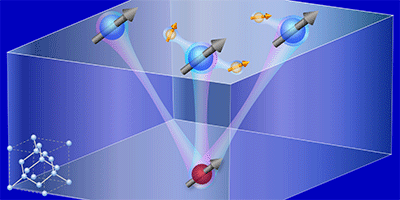NMR Sees the Spin of a Single Proton
To image the brain and other samples with sufficient contrast, nuclear magnetic resonance (NMR) scans must collect a signal from a large number of proton nuclear spins, which typically requires probing a volume that is at least micrometer-to-millimeter sized. Certain applications, however, like imaging a single protein or probing the pattern of ordered spins in a superconductor, require sensitivity to single spins. An NMR scheme with this capability has now been demonstrated by researchers at Harvard University, who used a scheme based on a nitrogen vacancy (NV) defect in diamond to pinpoint the locations of individual protons on the diamond surface.
NVs are extremely sensitive magnetic-field probes and have provided the basis for the NMR imaging of ensembles of a few nuclear spins. But they cannot be placed too close to the surface of a diamond chip without significant deterioration of their properties. This constrains the minimum distance the defect can be from a sample, limiting its detection sensitivity. To overcome this issue, groups led by physicist Mikhail Lukin and chemist Hongkun Park used certain defects naturally present on the diamond surface as “quantum reporters”—intermediaries that connect the NV with a sample. These defects, consisting of spin- electronic states, can sense the magnetic field from nuclear spins and transfer that information to a NV buried a few nanometers below the surface. The NV center can then be read out optically with the help of lasers. The researchers demonstrated that the scheme can detect and locate, with angstrom accuracy, individual protons from molecules on the diamond’s surface.
This research is published in Physical Review Letters.
–Matteo Rini





